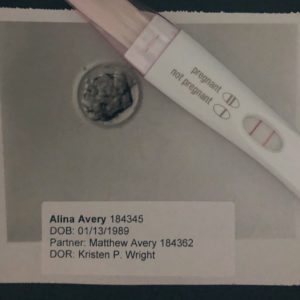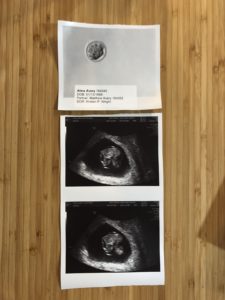Final Fertility Update – Our FET
By Alina Avery
After our first IVF cycle failed, we met with our Reproductive Endocrinologist to follow up on how the cycle went and what our next steps were.
We were very much on the same page, we were happy with how our cycle went right up until the negative pregnancy test. My response to the medication, egg retrieval, fertilization and maturation of the embryos was all pretty much textbook. We feel very lucky to have had such a positive experience. It was obviously going to be emotional and difficult and the fact that we weren’t one of the lucky unicorns who find success after their first cycle was upsetting, but not world ending. We did have 6 more frozen embryos and nothing about the cycle raised any red flags that indicated we would need to change treatments or do more testing.
So the next step for us would be an FET, a frozen embryo transfer. Compared to the stim cycle, this would be a walk in the park. There were two options for us, a “natural” cycle, or a medicated one. During a natural cycle, you’re monitored similar to how you are for a stim cycle to pinpoint your natural ovulation. Then 5 days later, a 5-day old embryo is thawed and transferred when your uterus is receptive. The pros here: little to no medication. The cons: lots of visits to the lab for monitoring, less control over timing. Since I prefer more control and less poking (blood draws) and prodding (internal ultrasounds), I opted for a medicated transfer. What that meant was that at the start of my next cycle, I would start taking oral estrogen pills as well as using estrogen patches to both suppress my natural ovulation and begin to build a uterine lining. After two weeks of that, I would go into the lab for a lining check where they would do just one blood draw and ultrasound in order to make sure the estrogen had done its job. They were looking for low progesterone, meaning I hadn’t spontaneously ovulated, and high estrogen. I believe for the uterine lining, they were looking for something over 8mm and mine was 9.5mm, so all signs pointed towards go. And that’s when I started the most tedious point in the process: Progesterone In Oil injections, or PIO.
PIO is an intramuscular shot. Meaning that instead of a tiny, short little subcutaneous needle into your belly like the stim injections, it’s a massive long 1.5 inch needle that goes into your bottom. I needed to do one injection every day around the same time every day. It’s nearly impossible to do yourself and after daily injections, even after switching sides, your butt gets bruised and sore.
The progesterone injections are intended to simulate ovulation. It changes the quality of the uterine lining to be sticky and holds it in place so that the embryo can implant in it. In a natural cycle, progesterone is produced by the follicle left behind on the ovary once the egg is released. Since I wasn’t actually releasing an egg this cycle, I had to supplement my progesterone. So after 5 days of progesterone injections, we went in for the FET.
It was very similar to the process for a fresh transfer. I needed to have a full bladder again, but this time I overdid it and was told I could try to partially relieve myself so I wasn’t in pain. I had to do that at least twice and still when the ultrasound tech came in the first thing she said was “whoa, good job with that bladder!” Matt commented that he could see a lot more definition on the ultrasound screen looking at my uterus this time. It was pretty clear to see the outline of the organ, the lining, and where the little embryo ended up. After the transfer, they gave us a photo again, told us to come back in two weeks for a pregnancy test, and to continue the progesterone injections and estrogen pills and patches.
I had a minor freak out a few days later when we got about 6-8 inches of snow. Matt injured his back at the gym, so digging the car out was up to me. I thought maybe I’d over done it shoveling snow, even though I hadn’t gotten out of breath and was careful not to lift any too heavy shovel loads. I was a bit paranoid that I’d managed to dislodge our precious embryo. Some incessant googling calmed me down though.
Two days after that, we boarded a flight to London. Remember when I said the PIO shots had to be done around the same time every day? Well we’d started doing the shots around 9pm eastern time, which meant that 1. we had to do a shot at the airport and 2. we’d be doing the shots at 2am while we were in London. The shot at the airport was difficult for me. The only private place we found to do it at Logan Terminal E was a breast feeding/pumping pod, which felt ironic and a little like adding insult to injury. The code to get in was 80085 though (BOOBS) which I found funny at least. Also in case you’re curious, needles and syringes are totally fine to pack in your carryon. We had a note from the doctor that they were medically necessary, but no one gave us a hard time about it. The 2am shots in London weren’t actually as bad as we thought they might be. The nice part was that we were always back in our room and not out-and-about doing tourist-y things. We just prepped everything before we went to bed, set a phone alarm for 2am, and when it went off, sleepily drew up the injection and administered it.
We had a fantastic time in London. It was a great way to distract myself from constantly wondering if the transfer had worked or not. We flew back to Boston on a Sunday evening and my pregnancy test was scheduled for early Tuesday morning. Monday morning I woke up around 3am to pee and probably a bit due to jetlag. Since I was up and going anyway, I decided to take a home test, fully expecting it to be negative so I could brace myself for the next day’s blood test. I think you could have knocked me over with a feather when two dark lines showed up almost immediately. Once I convinced myself I wasn’t actually dreaming, I ran back into the bedroom to wake Matt up and make him look at the test. He was definitely still very much asleep but similarly excited to see our first ever positive pregnancy test.

My HCG level on Tuesday was around 1500. They scheduled another draw for two days later to make sure the levels were rising appropriately. That one came back at 2800, which the nurse described as “perfect”. A final draw a week later came back at almost 16,000 which pretty much meant that I was definitely pregnant and it was looking viable. Slow rising or dropping HCG levels can indicated a chemical pregnancy, where the embryo implants but fails to grow shortly after, or an ectopic pregnancy where the embryo manages to find its way out of the uterus and implant somewhere it shouldn’t. They’d have me in for an ultrasound to confirm placement two weeks later. Those two weeks CRAWLED by. Like I said… lots and lots of anxious waiting in this process!
Our ultrasound was scheduled for when I was 7 weeks and 6 days pregnant and our little embryo measured exactly on track with a strong heartbeat. At that point we were released from the fertility clinic and were transferred to an OB for standard prenatal care. That was obviously the good news. The bad news was I was still required to continue the PIO injections and would need to keep doing them until I was 10 weeks pregnant.

Looking back, my “symptoms” while we were in London could have been due to the progesterone or the time change, but I was exhausted. Especially towards the end of the trip, I couldn’t keep my eyes open. I thought my sense of smell on the plane home was a bit more sensitive than usual, and I completely lost my taste for wine. We planned a little wine tasting with our friends one of the last evenings there where we bought a few nice bottles and wanted to taste them side by side and compare notes. Every glass tasted awful to me. I was completely disinterested in drinking any sort of wine, which is very unusual for me!
